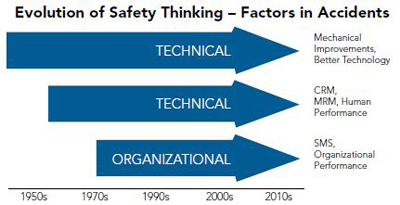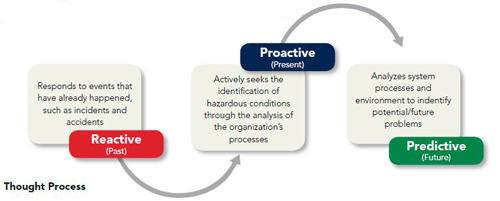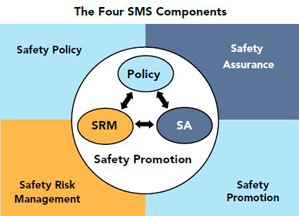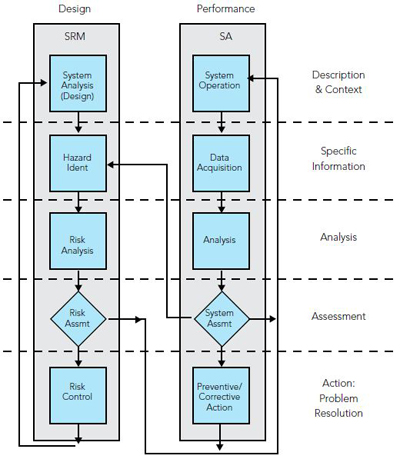
Safety Management - WHAT IS IT AND WHAT DOES IT MEAN TO YOU?

R. Fred Polak | Editor
Visit an operator or an MRO, and you will hear talk from flight crew and maintenance specialists about the proposed Safety Management System (SMS), and how it will affect their responsibilities and how they perform them. Since SMS is essentially a done deal, now is a good time to highlight just what SMS is and get everyone on board with its basics.
According to the FAA, the concept known as the SMS is becoming a standard throughout the aviation industry worldwide. It is recognized by the Joint Planning and Development Office (JPDO), International Civil Aviation Organization (ICAO) and Civil Aviation Authorities (CAA) and product/service providers as the next step in the evolution of safety in aviation. SMS is also becoming a standard for the management of safety beyond aviation. Similar management systems are used in the management of other critical areas such as quality control, occupational safety and health, security and the environment.
The SMS for product/service providers (certificate holders) and regulators will integrate modern safety risk management and safety assurance concepts into repeatable, proactive systems. The SMS emphasizes safety management as a fundamental business process to be considered in the same manner as other aspects of business management.
By recognizing the organization’s role in accident prevention, the SMS provides to both certificate holders and the FAA:
• A structured means of safety risk management decision making
• A means of demonstrating safety management capability before system failures occur
• Increased confidence in risk controls though structured safety assurance processes
• An effective interface for knowledge sharing between regulator and certificate holder
• A safety promotion framework to support a sound safety culture
Here is a hypothetical scenario provided by the FAA demonstrating the need for a SMS:
A well-designed aircraft with a history of reliable service is being prepared for a charter flight. Employees tow the aircraft from the hangar to the terminal. One employee sees wetness on the right tire as he unhooks the tow bar. However, he does not give it attention, as he is very busy and has three other aircraft to move in the next 15 minutes.
At the same time, a safety inspector is walking through the hangar when she encounters a hydraulic oil spill on the hangar floor. She notifies a janitor to clean up the slip hazard as she leaves. While cleaning the spill, the janitor wonders aloud where the spill came from. Afterwards, both the inspector and the janitor continue with their respective jobs.
Meanwhile, the Chief Pilot assigns the charter flight to a new pilot with the company. While new to the company, the pilot is well trained and prepared for the flight. He is also eager to do a good job and to impress the chief pilot. The chief tells him that the passengers and the aircraft are waiting at the terminal, and the new pilot has to get over there right away to keep the clients happy and on schedule.
The flight requires a little more fuel, so a fuel truck is called. While the aircraft is being filled, the fueler notices a small puddle of reddish fluid under the right main landing gear. He sees the pilot walking out to the aircraft, but before he can say anything, his supervisor calls and tells him to get right over to another aircraft. Recently, the fueler was criticized by his supervisor for taking too long to finish his work, so he quickly jumps in his truck and drives off to the next job without saying anything to the pilot.
The pilot, wanting to make a good impression on his passengers and the chief pilot, personally escorts them to the aircraft and begins his preparation for the flight. One passenger asks him a brief question as he is on the right side of the aircraft. In a moment of distraction, he does not bend down to inspect the right-hand main landing gear.
During taxi, the pilot feels the aircraft is taking the bumps a little hard, but continues to the runway for take off. Meanwhile, up in the tower, an air traffic controller, who happens to like this particular model of aircraft, picks up her binoculars to take a look at the taxiing aircraft. She notices a “wet spot” on the right main tire and radios the pilot. The pilot tells the controller that he probably ran over a puddle and asks for his clearance.
At the destination airport, the pilot executes a perfect landing and applies the brakes. The leaking hydraulic fluid heats up and ignites. The right main landing gear is engulfed in flames. The controller notifies the pilot and then calls the crash fire rescue squad. The pilot calmly and proficiently manages the situation, successfully evacuating everyone from the aircraft without injury. The pilot and passengers watch from a safe distance while a perfectly good aircraft burns to the ground. “How could this have happened?” wonders the pilot.
Soon afterwards, the pilot is fired for failure to perform an adequate preflight inspection. Six months later, an aircraft is being towed out of a hanger. One of the employees sees wetness on the left main landing gear tire as he unhooks the tow bar ...
SMS Key Point – Decision Making
SMS is all about safety decision making throughout the organization.
Technology and system improvements have made great contributions to safety. However, part of being safe is about attitudes and paying attention to what your surroundings are telling you. Whether through data or through the input of employees and others, recognizing that many opportunities exist to stop an accident is the first step in moving from reactive to predictive thinking.
Safety begins from both the top down and the bottom up. Everyone from the receptionist, ramp worker, maintenance specialist, pilot, manager and FAA Inspector has a role to perform. SMS is all about decision making. It has to be a decision maker’s tool, not a traditional safety program separate and distinct from business and operational decision making.
Evolution of Safety Management
An SMS is the product of a continuing evolution in aviation safety. Early aviation pioneers had little safety regulation, practical experience or engineering knowledge to guide them. Over time, careful regulation of aviation activities, operational experience and improvements in technology have contributed to significant gains in safety. In the next major phase of improvement to safety, a focus on individual and crew performance or “human factors” will further reduce accidents.
 Each approach has led to significant gains in safety. However, even with these significant advances, we still have opportunities to take preventative action against accidents. The question for the aviation community is, “What is the next step?”
Each approach has led to significant gains in safety. However, even with these significant advances, we still have opportunities to take preventative action against accidents. The question for the aviation community is, “What is the next step?”
Careful analysis typically reveals multiple opportunities for actions that could have broken the chain of events and possibly prevented an accident. These opportunities represent the organization’s role in accident prevention. The term “organizational accident” was developed to describe accidents that have causal factors related to organizational decisions and attitudes. SMS is an approach to improving safety at the organizational level.

How the SMS Addresses the Organization’s Role in Safety
SMS requires the organization itself to examine its operations and the decisions around those operations. It allows an organization to adapt to change, increasing complexity and limited resources. SMS also promotes the continuous improvement of safety through specific methods to predict hazards from employee reports and data collection. Organizations will then use this information to analyze, assess and control risk. Part of the process also includes the monitoring of controls and the system itself for effectiveness. SMS helps organizations comply with existing regulations while predicting the need for future action by sharing knowledge and information. Finally, SMS includes requirements that will enhance the safety attitudes of an organization by changing the safety culture of leadership, management and employees. All these changes are designed to move the organization from reactive thinking to predictive thinking.
Support Builds as Benefits Become Apparent
SMS has generated wide support in the aviation community as an effective approach that can deliver real safety and financial benefits. SMS integrates modern safety concepts into repeatable, proactive processes in a single system, emphasizing safety management as a fundamental business process to be considered in the same manner as other aspects of business management. The structure of SMS provides organizations greater insight into their operational environment, generating process efficiencies and cost avoidance. Some participants have found that benefits begin to materialize even in the early reactive stages of implementation. This continues as organizations evolve from reactive to proactive and predictive phases.

SMS Key Point – Functional Components
The essential idea of any SMS — be it a product/service provider’s SMS or the SMS of the regulator responsible for safety oversight — is to provide for a systematic approach to achieving acceptable levels of safety risk. SMS is comprised of four functional components, including an intangible (but always critical) aspect called safety culture.
1. Safety Policy — Establishes senior management’s commitment to continually improve safety; defines the methods, processes and organizational structure needed to meet safety goals.
• Establishes management commitment to safety performance through SMS
• Establishes clear safety objectives and commitment to manage to those objectives
• Defines methods, processes and organizational structure needed to meet safety goals
• Establishes transparency in management of safety
-
Fully documented policy and processes
-
Employee reporting and resolution system
-
Accountability of management and employees
• Builds upon the processes and procedures that already exist
• Facilitates cross-organizational communication and cooperation
• Current SMS Policy Documents:
-
Order 8000.369, FAA SMS Guidance
-
Order VS 8000.367 AVS SMS.
2. Safety Risk Management (SRM) — Determines the need for and adequacy of new or revised risk controls based on the assessment of acceptable risk.
• A formal process within the SMS composed of:
-
Describing the system
-
Identifying the hazards
-
Assessing the risk
-
Analyzing the risk
-
Controlling the risk
• The SRM process may be embedded in the processes used to provide the product/service.
3. Safety Assurance (SA) — Evaluates the continued effectiveness of implemented risk control strategies and supports the identification of new hazards.
• SMS process management functions that systematically provide confidence that organizational outputs meet or exceed safety requirements
• AVS SMS has a dual safety assurance focus:
-
AVS organizations
-
Product/service providers
• Ensures compliance with SMS requirements and FAA orders, standards, policies and directives
-
Information acquisition
-
Audits and evaluations
-
Employee reporting
-
Data analysis
-
System assessment
• Provides insight and analysis regarding methods/opportunities for improving safety and minimizing risk
• Existing assurance functions will continue to evaluate and improve service.
4. Safety Promotion — Includes training, communication and other actions to create a positive safety culture within all levels of the workforce.
• Safety promotion activities within the SMS framework include:
-
Providing SMS training
-
Advocating/strengthening a positive safety culture
-
System and safety communication and awareness
-
Matching competency requirements to system requirements
-
Disseminating safety lessons learned
• Everyone has a role in promoting safety.
Interfaces Between SRM and SA
SRM and SA are key processes of the SMS. They are also highly interactive. The flowchart on the next page may be useful to help visualize these components and their interactions. The interface attribute concerns the input-output relationships between the activities in the processes. This is especially important where interfaces between processes involve interactions between different departments, contractors, etc. Assessments of these relationships should pay special attention to flow of authority, responsibility and communication, as well as procedures and documentation.
Key Point - The Relationship between Quality and Safety in Aviation Safety (AVS)
A Quality Management System (QMS) is a means of ensuring that an organization is meeting requirements and continuously improving its processes. In AVS, an organization’s QMS is focused on safety. They have established a quality policy, objectives, QMS process documents and measures that focus on safety. They meet the FAA’s safety requirements by making sure they meet the requirements of the FAA’s orders, QMS documents and other policy documents.

The AVS QMS is the foundation for the AVS SMS. The QMS has already established many of the processes that the SMS requires, such as management review, analysis of data, corrective action and internal audit. Some improvements to QMS processes are needed to fully meet SMS requirements. Examples include establishing processes to better identify new hazards and establishing processes to measure the effectiveness of safety risk controls. These improvements will be developed during the SMS implementation effort during the next several years. Safety management and quality management are highly complementary and work closely together to achieve the overall safety goals of AVS. SMS is what we do and QMS is how we do it.
Key Point - Regulation and SMS
The FAA is doing SMS because it is the right thing to do. SMS applies modern management methods to the processes involved in safety decision making. It expands on the basic system safety initiative that was started by the FAA more than a decade ago. SMS provides a formal management framework that can serve as a valuable interface between regulator and service provider. The FAA began the move to system safety and then to SMS before the International Civil Aviation Organization (ICAO) requirement that exists because of growing realization around the world of the need to add this new approach to the aviation industry’s safety strategy. In fact, we as “Member States” are requiring ICAO to incorporate SMS requirements because of the safety benefits.
The FAA is engaged in an SMS rulemaking effort corresponding to changes made in ICAO Annex 6 as well as FAA internal system safety objectives. While the FAA is following its formal rulemaking protocol, (as codified in the Aviation Rulemaking Committee Charter, FAA Order 1110.152), the FAA is conducting SMS Pilot Projects for external SMS. While the FAA encourages each aviation product/service provider to develop and implement a SMS, these systems in no way substitute for regulatory compliance of other certificate requirements where applicable.
Key Point – Misconceptions and SMS
While the principles of SMS are not new, there are many misunderstandings about it, especially in distinguishing safety management systems for product/service providers and regulators.
What are the most common misconceptions about SMS for service providers?
SMS is not just a new “buzzword” to replace “system safety.” To the contrary, SMS applies system safety concepts and adds formal system safety management concepts. It creates an avenue for a more effective interface between product/service providers and their oversight organizations. SMS is the next logical step in system safety evolution.
SMS will not require a separate safety department. While larger organizations may have specialist personnel such as a Director of Safety, safety and quality auditors and analysts, investigators, etc., in the same manner that they may now employ accountants, attorneys or other specialists in financial and business management, an SMS is a set of management practices rather than a requirement for an additional organizational “layer” or “stovepipe.” SMS focuses on functional expectations by operational departments. Resource allocation should be appropriate for the size of the organization. SMS Pilot Project Participants have found that SMS resources are critical to successfully champion SMS development and implementation.
SMS will not require a QMS. If an organization has a QMS, it should not conflict with the SMS.
SMS will not require an ASAP (Aviation Safety Action Program); Voluntary Employee Reporting programs are a requirement for an SMS, but no specific program is specified.
What are the most common misconceptions about SMS for regulators?
A SMS does not rescind the FAA’s responsibility as regulator. While the FAA feels that a positive, proactive relationship with product/service providers is preferable to an adversarial legalistic stance, they must and will maintain their position of providing effective safety oversight. What an SMS will give the FAA in this area is a clear set of requirements for product/service providers to demonstrate their safety management capability. However, the importance of meeting technical standards will still be emphasized, and the FAA will continue to validate product/service providers’ attainment of them.
An SMS is not a means of outsourcing FAA work or of diminishing the status of the FAA’s Technical Workforce. In an increasingly large and complex aviation system, the FAA will always need inspectors, engineers, flight test pilots and other technical employees. They do not envision a scenario where either numbers or required expertise of the technical workforce can be decreased without decreasing oversight effectiveness. What SMS will give the FAA is a framework to work with industry, to increase safety management effectiveness and to allow the FAA to better prioritize resources. If anything, competencies required in the areas of safety analysis, system evaluation and risk assessment will elevate inspector knowledge and needed skills. This will also make it incumbent on the FAA to provide the necessary training to upgrade the skills of their workforce.
SMS is not interchangeable with FAA Oversight Systems. Both oversight systems and product/service providers’ SMS will be part of the FAA’s comprehensive safety management approach. Oversight systems are the FAA’s means of meeting their responsibility for safety assurance of the air transportation system. On the other hand, the operator’s SMS will be a formal means for product/service providers to demonstrate their management capability to meet their statutory obligation to operate “at the highest level of safety in the public interest.” Both oversight systems and product/service provider SMS will be highly complementary and interactive. They are both separate and essential components of the FAA safety management strategy.
It is a brave new world out there in the realm of aviation safety practices. SMS is another tool. Let’s use it well.
